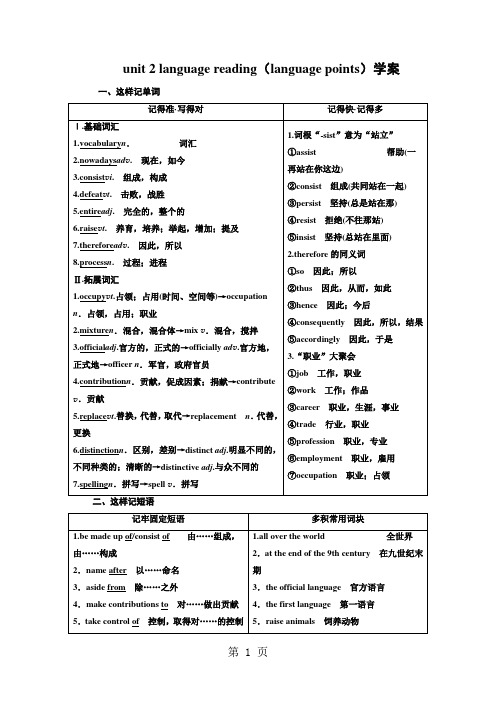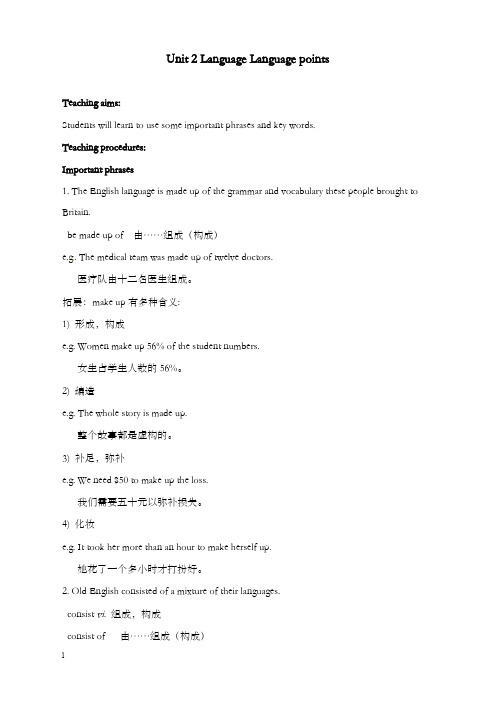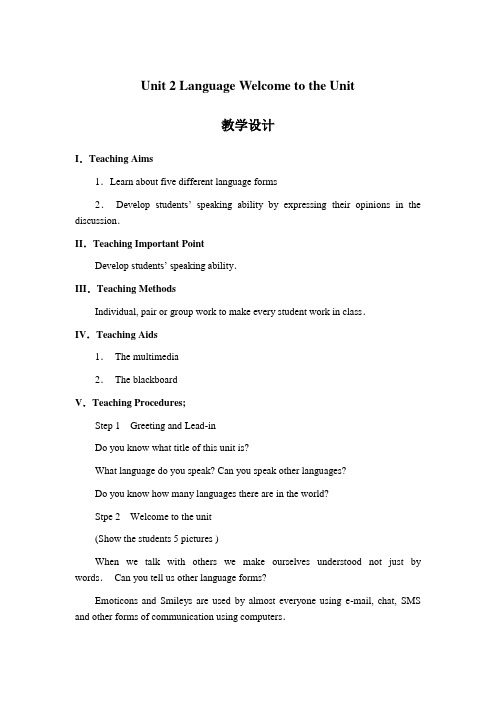2017--2018学年译林版必修三unit 2 language grammar学案-学习文档
2017--2018学年译林版必修三unit 2 language reading(language points)学案-学习文档

unit 2 language reading(language points)学案一、这样记单词这个俱乐部由二百多名成员组成。
②You will have to make up for all the things you have missed.你必须补上所有你错过的东西。
[名师点津]be made up of表示简单的组合;be made of表示“(成品)由……(原料)制成”,一般侧重能看出原材料的物理变化;be made from表示“(成品)由……(原料)制成”,一般侧重看不出原材料的化学变化;be made into表示“(原材料)被制成……”。
③As we all know, paper is made from wood.众所周知,纸是由木材制造的。
[语境串记]Our class is made up of forty students.Some girls in our class like making up so much that they are often late for classes.When our teachers ask, they usually make up excuses for it.我们班由40名学生组成。
班里一些女生很喜欢化妆以至于经常迟到。
当老师们问时,她们常编造借口应对。
2.(教材P22)Then two Germanic groups from the European mainland — the Angles and the Saxons —occupied Britain.然后,来自欧洲大陆的两个日耳曼部族——盎格鲁人和撒克逊人——占领了不列颠。
occupy vt.占领;占用(时间、空间等);居住;使忙碌她的演说占用了3个小时。
②Mrs Green occupies herself in looking after her three children.=Mrs Green is_occupied_in_looking after her three children.格林夫人忙于照料她的三个孩子。
牛津译林版高中英语必修三unit 2《language》language points优秀教案(重点资料).doc

Unit 2 Language Language pointsTeaching aims:Students will learn to use some important phrases and key words.Teaching procedures:Important phrases1. The English language is made up of the grammar and vocabulary these people brought to Britain.be made up of 由……组成(构成)e.g. The medical team was made up of twelve doctors.医疗队由十二名医生组成。
拓展:make up有多种含义:1) 形成,构成e.g. Women make up 56% of the student numbers.女生占学生人数的56%。
2) 编造e.g. The whole story is made up.整个故事都是虚构的。
3) 补足,弥补e.g. We need $50 to make up the loss.我们需要五十元以弥补损失。
4) 化妆e.g. It took her more than an hour to make herself up.她花了一个多小时才打扮好。
2. Old English consisted of a mixture of their languages.consist vi.组成,构成consist of 由……组成(构成)e.g. A university consists of teachers, administrators and students.大学由教师,行政人员和学生组成。
Our book consists of 3 units.我们的书有3单元。
consist with 一致,相符e.g. Our deeds must consist with our words. 我们必须言行一致。
新牛津译林版高中英语必修三unit 2《language》welcome to the unit优秀教案(重点资料).doc

Unit 2 Language Welcome to the unitTeaching Aims:◆To introduce languages in the world.◆To talk about other forms of languages .◆To practise students’speaking abilityTeaching Procedure:Step One: Leading-inIntroduce la nguages i n the world, such as Chinese, Russian, English ,Spanish , Japanese, Tibetan ,French ,Ar abic ,Greek, German.What language do you speak? Can you speak other language?Do you know how many languages there are in the world?Do you speak any other language besides Chinese? If so, can you speak a little for us? Which other language do you like to learn best? Why?Which language do you think is the hardest? Why?Step Two: SpeakingAsk students the question: do you know other forms of languages? And show them emoticon and see if they know all of them.Ask students to think about what sign language is and show some pictures about it.Step Three: Further DiscussionIntroduce the language for the blind and the inventor of it. Ask students to discuss if English is important and why.Do you think that language is the only way people communicate?What other methods of communication can you think of?What will you do if you w ant to say “ok”to your friend, but she/h e couldn’t hear you? Step Four: HomeworkPreview the Reading part.。
【教育课件】牛津译林版高中英语必修三Unit2《Language》grammar课件.ppt

1. 名从的三大考点: -- 区分 -- 连接词 -- 语序
2. 形式主语“it” 3. 名从中的虚拟语气
名词性从句中的虚拟语气问题: 1. 在suggest, advise,order,demand,
request,desire等所接的宾语从句中用should 型虚拟语气。should 常省略。 在order, suggestion等名词后同位语从句,表语从句中用 should 型虚拟语气,可省略should.
3. 在suggest,insist后会出现两种语气:
He suggested that I (should)turn to my boss.
The expression on his face suggested that he was angry
The old man insisted that he was still young.
The expression on his face suggested that he was angry
The old man insisted that he was still young.
The police insisted that we should offer proof.
4. 在主语从句中: It is necessary / important / strange /
高考链接
1、Someone is ringing the doorbell. Go and
see ____.
(全国2000)
A. who is he
B. who he is
C. who is it
D. who it is
2、The photographs will show you ____.
译林牛津版高一英语必修3学案Unit2LanguageProject

Teaching aims:1.Get to know the development of Chinese characters.2.Get informed of the formation of Chinese characters.3.Learn to explain the Chinese character by the way it forms.Teaching procedures:Step 1 LeadinDevelopment of Chinese charactersGet the class to think of these questions1. When did the Chinese writing begin ?2. Who invent the Chinese writing ?3. Can you tell something more about the Chinese writing?_____________________________________________________________________Step 2 Reading (the development of Chinese characters)1)Fast readingSkim the text and discuss the structure of the text between partners. Think about how many parts we can divide the whole text into.Part 1: Para 1 ________ of Chinese characters.Part 2: Para 2 ________of Chinese characters.Part 3: Para 34 ________ of Chinese characters.Part 4: Para 5 _________of Chinese characters.A.The origin of Chinese characters.B.Simplified Chinese characters.C.Brief introduction of Chinese characters.D. Form and development of Chinese characters.2) Careful readingPart1What makes the Chinese language differ from many Western languages?_____________________________________________________________________Part 2Who is said to have invented Chinese writing? _______________________________ What fired his idea of inventing Chinese characters?_____________________________________________________________________Part 3How are Chinese characters formed?1.___________________________________________________________________2.___________________________________________________________________3.___________________________________________________________________Part 4When were simplified Chinese characters introduced by the Chinese government? ________________________________Where are simplified Chinese characters used? _______________________________ Step 3 Reading(The story of Braille)Read the second passage and answer the questions:(1)Who introduced blind people to rreading?________________________________(2)At Braille’s time, what were the books for blind people like? __________________________(3) What happened to him when he was three years old?______________________(4) What did the soldier do for students when he visited the school?_____________________________________________________________________(5) What contributions did Louis Braille make for blind people?_____________________________________________________________________Step 4 Language points见基础训练P4650Step 5 语法填空The Chinese language ________(differ) from western languages. It uses characters to stand ________ ideas, objects or deeds. Chinese words are often formed by ________(put )together different characters. We can see the history of the Chinese language by looking at how these characters developed.Chinese writing began thousands of years ago. It is said that Cang Jie invented Chinese writing. He had the idea ________he could use different ________(shape) to represent different objects at the sight of the tracks of animals in the show. The first Chinese characters were drawings of physical objects. Some characters________ (simplify) and others have been made more difficult over time. However, as________whole, the characters have developed from drawings into standard form.Not all characters were developed from drawings of objects. Some characters were made by bing two________more characters together eg. ‘rest’ and ‘prisoner’. Other characters were developed for directions and numbers. ________is easy to distinguish their meanings by looking at them, eg. ‘up’ and ‘down’. Many other Chinese characters were made by having one part of a character indicate the meaning and the other suggested the pronunciation.In 1950s the Chinese government introduced simplified Chinese characters, which are ________(wide) used in China’s mainland now.。
2017-2018学年高中英语译林版必修三教学案:Unit 2 Section Ⅴ Project 含答案 精品

Section_ⅤProject[原文呈现][读文清障]The development of Chinesecharacters①The Chinese language differs from②Western languages in that③,instead of an a lphabet④,it uses characters ⑤which stand for⑥ ideas, objects ordeeds⑦.Chinese words are formed by putting together different characters.In many cases⑧, a single character can also make up⑨ a word.The history of the Chinese language can be examined by looking at how these characters developed.Chinese writing○10began thousands of years ago.Accordingto⑪an ancient story, a man namedCang Jie⑫invented⑬Chinesewriting.One winter day while hewas hunting⑭,he saw the tracks⑮of animals in the snow and observed that the appearance⑯of each one was different.Then he had the idea ⑰that he①Chinese character 汉字②differ from和……不同,不同于differ/'dIfə(r)/v i.相异,有区别③in that“在于,因为”,引导原因状语从句。
牛津译林版必修三Unit2Language

Unit 2 Language Welcome to the Unit教学设计I.Teaching Aims1.Learn about five different language forms2.Develop students’ speaking ability by expressing their opinions in the discussion.II.Teaching Important PointDevelop students’ speaking ability.III.Teaching MethodsIndividual, pair or group work to make every student work in class.IV.Teaching Aids1.The multimedia2.The blackboardV.Teaching Procedures;Step 1 Greeting and Lead-inDo you know what title of this unit is?What language do you speak? Can you speak other languages?Do you know how many languages there are in the world?Stpe 2 Welcome to the unit(Show the students 5 pictures )When we talk with others we make ourselves understood not just by words.Can you tell us other language forms?Emoticons and Smileys are used by almost everyone using e-mail, chat, SMS and other forms of communication using computers.2.Sign language is a language form used by the deaf and dumb.Show more gestures and let the students guess the meanings.3.Braille is a special language for blind people.Anima languageWatch a videoStep 3 Pair WorkLook at the illustrations at P.21 and talk about the various forms of language.Step 4 Group WorkCan you think of other ways that information can be exchanged?Do you think English is important? Why or why not?Do you have any effective methods for studying the English language to share with your classmates?Step 5 Language PointsStep 6 Homework1.Find more information on the Internet or in books.2.Preview the reading text.。
2017 2018译林版必修三unit 2 language welcome to the unit学案 word文档资料

unit 2 language welcome to the unit学案Please match the words with their proper meanings.1.occupy A.现在,如今2.replace B.击败,战胜3.process C.占领,占用(时间、空间)4.nowadays D.替换,代替,取代5.defeat E.因此,所以6.raise F.完全的,整个的7.therefore G.仆人8.entire H.养育;举起;筹募9.servant I.过程;进程10.distinction J.区别,差别答案:1~5CDIAB6~10HEFGJⅠ.Do you recognize all the languages below?1.新年快乐!Chinese2.Happy New Year! English3.Bonne Année! French4.Glückliches Neues Jahr! German5.あけましておめでとうございます!JapaneseⅡ.Match the following pictures with the meaning of the sign language.A.Call me! B.Thumbs down!C.Applause!D.Victory/Win! E.Thumbs up! F.OK!答案:1.E 2.B 3.D 4.F5.A6.CⅠ.Fast-reading1.Look at the title and the subtitle (副标题) before each section, and then finish the following question.This passage is about the_developing_history of English.2.Put the following sentences in the right order.A.In 1399, Henry Ⅳbecame King of England and used English for all official occasions. B.By the 10th century, Old English was the official language of England.C.During the Renaissance in the 16th century Modern English began.D.By the latter half of the 14th century English was adopted by all classes in England. E.Before the middle of the 5th century, people in Britain all spoke a language called Celtic.F.In 1066, the Normans conquered England and took control of the country.G.At the end of the 9th century, the Vikings invaded Britain and brought their languages.答案:EGBFDACⅡ.Careful-reading(Ⅰ)Choose the best answers according to the text.页 - 1 - 第1.What is the main reason for English's development?A.The borrowing from other languages.B.The mixing of different languages from different countries.C.The invasions.D.All of the above.2.Old English consists of different languages used by different people.Which of the following is NOT mentioned in the text?A.The Angles and the Saxons.B.The Vikings.C.French.D.Celtic.3.Which language had an important effect on the English language during Middle English period?A.German.B.French.C.Latin. D.Greek.4.Which of the following is TRUE about the history of English?A.The language used before the middle of the 5th century is called Old English. B.Middle English started from about the 12th century and ended in the 15th century. C.Only the English we are using today is Modern English.D.The process of English's development will not continue any more.5.Which of the following terms come from French?A.Beef, sheep and bacon.B.Feet, children and shoe.C.Pig, mutton and tooth.D.Beef, pork and bacon.答案:1.D2.C 3.B 4.B 5.D(Ⅱ)Fill in each blank with no more than three words.页 - 2 - 第.Study-readingⅢAnalyze the following difficult sentences in the text.When we speak English today, we sometimes feel puzzled about which words or phrases to 1.use.][句式分析如今,我们在说英语时,有时候对于用哪个词汇或短语感到困惑。
2017--2018学年译林版必修三Unit 2 language Grammar and usage学案

Unit 2 language Grammar and usage学案Ⅰ.重点单词1.n.关心;忧虑;v t.涉及;使担忧;对……感兴趣adj.担心的,担忧的;有关联的2.v t.& n.禁止;取缔3.adj.纯的,纯净的;纯粹的4.adj.独特的5.v t.进入;使用;n.通道;(使用的)机会,权利6.n.(书写或印刷)文字;符号;人物;性格7.n.& v i.(狗)叫8.adj.人种的,种族的n.种族,比赛Ⅱ.重点短语1.依赖,依靠2.而不是3.阻止某人做某事4.仰望;查阅;尊敬5.关心……6.为……设定标准7.曾经8.由于9.取决于10.可以获得/利用Ⅲ.重点句式1.动名词短语作主语will certainly be a waste of time.查找每一个生词当然会浪费时间。
2.What should I do if...?I understand now,but the question is I cannot guess the meanings. 我现在明白了,但问题是如果我猜不出其含义该怎么办呢。
重点词汇1.Depending on the situation in which the language is used,English can be formal or informal.根据语言被应用的情况,英语可以是正式的或者非正式的。
[归纳拓展](1)depend on/upon根据;相信,依赖depend on/upon sb.to do/doing sth.依靠/相信某人做某事It/That depends.视情况而定。
(2)dependent adj.依赖的,依靠的be dependent on/upon依赖,依靠……(3)independent adj.独立的,自主的(4)independently ad v.独立地[语境助记](1)He was the sort of person you could depend on.他这个人你是可以依赖的。
牛津译林版必修三Unit2Language

replace vt. 替换,代替,取代*despite prep. 尽管*impact n. 巨大的影响,冲击servant n. 仆人raise vt. 饲养ox n.(复数oxen)牛,公牛ending n. 词尾,结尾,结局upper adj. 上层的,上面的,上边的class n. 阶级,阶层department n. 部门ban vt. 禁止,取缔pure adj. 纯的,纯洁的spread n., vi & vt 传播easily adv. 容易地,不费力地access vt. 接近,使用n 接近的机会,享用权across prep. 在..... 各处,遍及racial adj. 种族的Module 3 Unit 2 Language新课标单词throughout prep. 贯穿,遍及confusing adj. 令人迷惑的,令人不解的vocabulary n. 词汇tribe n. 部落European adj. 欧洲的;欧洲人的n. 欧洲人create vt. 创造,创建,创作nowadays adv. 现今,现在official adj. 官方的,正式的consist vi. 组成consist of 由... 组成,由 ... 构成contribute vi. & vt 贡献con tribute to 是... 的成因之一development n. 发展;开发take control of 控制,取得对..的控制rule vt. & n 统治adopt vt. 采用tongue n. 语言;舌头mother tongue 母语,本国语modern adj. 近代的,当代的,现代化的,时髦的,时新的include vt. 包括pronunciation n. 发音,语音style n. 风格process n. 过程;进程depe nd vi. 视.... 而定,依靠depend on视 .... 而定;取决于,依赖于,依靠record vt. 记录promise vt. & vi 许诺,答应n. 许诺,诺言difficulty n. 困难unknown adj 不知道的,未知的disagree vi. 意见不一,分歧;不一致standard n. 标准adj. 标准的set vt. 确定〔标准等〕,制定〔标准等〕phrase n. 词组,短语differ fromrepresent vt. action n.combine vt. & vi 合writingn. drawing n. physical adj. square adj. 1. in a sense 2. stand for3. all over the world4. inform sb of sth5. throughout history6. be made up of7. bring sb with sth8. speak a language 9. be different from 10.consist of 11. the official language 12. find it hard to do sth 13. contributeto 14. take control of 15.be replaced with/by 16. even though 17. despite the factsymbol n.directionopposite n.物质的 indicate vt. pronounce vt. 课文出现短语18. have an impact on19. the English language20. result in 21. work as22. the way of doing sth23. because of 24. depend on 25. quite a few 26. make up27. have a word with sb28. a six-year-old kid29. right away 30. take action31. look forward to (doing) sth32. a waste of time 33. leave outoriginally adv. eventually adv. reflect vt. prisoner n.character n. (书写或印刷 )符号 Chinese character 汉字differ vi. 相异,有区别 n. 方型,正方形 simplify vt. 简化 complex adj. 复杂的和 ... 不同,不同于代表 行为,动作,行动 组合 ,〔使〕联合,〔使〕结文字;文字作品绘画,绘画艺术 有形的;实物的;方的,正方形的最初,原先,起先最后,终于,最终 反映,反射囚犯 符号;象征n. 方向 相反的事物,相对立的事物 显示,表示,象征,暗示 /八 发音 34. in any case 35. come true 36. look up 37. used to do sth 38. care about39. at one time 40. due to 41. get to the point 42. waste time doing sht 43. make fun of44. be used to do sth 45. in addition46. in a word47. it seems likely that48. sb is likely to do sth49. concentrate on50. in a short51. a written/spoken language52. differ from …in …53. as a whole54. develop into55. comb ine …together56. in the 1950s57. be widely used.单词应用根据单词的首字母或汉语意思填写正确单词,注意形式变化。
- 1、下载文档前请自行甄别文档内容的完整性,平台不提供额外的编辑、内容补充、找答案等附加服务。
- 2、"仅部分预览"的文档,不可在线预览部分如存在完整性等问题,可反馈申请退款(可完整预览的文档不适用该条件!)。
- 3、如文档侵犯您的权益,请联系客服反馈,我们会尽快为您处理(人工客服工作时间:9:00-18:30)。
unit 2 language grammar学案名词性从句词引导的名词性从句在句子中可以充当主语、宾语、表语或同位语(1)主语从句What you need is more practice.你需要的是更多的练习。
Where we will go hasn't been decided.我们要去哪儿还没有定下来。
When they will come hasn't been made public.他们什么时候来还没有公布。
[即时演练1](1)单句语法填空①(2019·江苏高考)Where Li Bai, a great Chinese poet, was born is known to the public, but some won't accept it.②(陕西高考)When the delayed flight will take off depends much on the weather.③(北京高考)What makes the book so extraordinary is the creative imagination of the writer.(2)完成句子①他为什么要这样做还不知道。
Why_he_did_this is not known.②我们不能得到的似乎比我们已经拥有的更好。
What_we_can't_get seems better than what we have.③谁做的这件事还不知道。
Who_did_it is unknown.(2)宾语从句I want to know what he has told you.我想知道他告诉了你什么。
She always thinks of how she can work well.她总是在想怎样能把工作做好。
Please tell me whose book it is.请告诉我这是谁的书。
[即时演练2](1)用适当的词填空,使句子意思完整①We don't know who will be sent to solve the problem.②He didn't tell me what he would do next.③Can you tell me how I can use the new machine?④I haven't decided when I will go back, perhaps the day after tomorrow.(2)单句语法填空①(2019·浙江高考)If you swim in a river or lake, be sure to investigate what is below the water surface. Often there are rocks or branches hidden in the water.②(全国卷Ⅱ)Police have found what appears to be the lost ancient statue.(3)表语从句The question is how we should carry out the plan.问题是我们应该怎样执行这个计划。
This is where our problem lies.这就是我们的问题所在。
[名师点津]because和why都引导表语从句,why从句后的内容表示的是结果,而because 从句内容表示的是原因。
[即时演练3](1)单句语法填空①(江苏高考)—What a mess! You are always so lazy!—I'm not to blame, mum. I am what you have made me.②(北京高考)The best moment for the football star was when he scored the winning goal.(2)完成句子①今日的中国不再是过去的中国了。
China is no longer what_she_used_to_be.②那正是他对我生气的原因。
That's why_he_got_angry with me.③问题是谁能代替他。
The question is who_can_take_the_place_of_him.④那不是他想要的。
That's not what_he_wants.(4)同位语从句I have no idea what he thinks of the plan.我不知道他怎么看待这个计划。
We don't understand the problem why this is the best choice.我们不明白这个问题——为什么这是最好的选择。
[即时演练4]单句语法填空/句型转换①(重庆高考)—Is it true that Mike refused an offer from Yale University yesterday?—Yeah, but I have no idea why he did it; that's one of his favorite universities.②The teacher didn't know the reason why Jack was absent.→The teacher had no idea why Jack was absent.③We haven't decided where we are going to spend our holiday.→We haven't settled the pr oblem where we are going to spend our holiday.2.连接代词和连接副词的选择连接代词和连接副词的选择要把握住两点:(1)成分:连接代词在从句中作主语、宾语、表语或定语;连接副词在从句中作状语。
(2)意义:无论是连接代词还是连接副词,都有各自的意义。
That's where the accident took place.那就是事故发生的地方。
(作状语,意为“……的地方”)She didn't know who/whom we were talking about.她不知道我们在谈论谁。
(作介词宾语,意为“谁”)[即时演练5](1)选词填空:when, why, how, which, what, who, whom①Do you know when the train arrives?②Can you tell me why you chose the topic to write an article?③How I can make greater progress later is a problem.④Which team will win is not clear.⑤What I want to know is who took away my book.⑥The problem is whom we should have do it.(2)单句语法填空(全国卷Ⅰ)We haven't discussed yet where we are going to place our new furniture.3.what与that的用法区别(1)that只起连接作用,在从句中不充当任何成分,也无任何意义。
(2)what引导从句,除起连接作用外,还在从句中作主语、宾语、表语等成分,这时what 具有两个含义:①保留疑问的意义,即“什么;什么样的”;②相当于“the thing(s) that/which”,即“先行词+定语从句”的含义。
另外,what的此种用法还可以表示时间(the time that)、地点(the place that)、人物(the person that)、数目(the amount/number that)等不同概念。
Our income is now double what it was ten years ago.我们现在的收入是10年前的两倍。
The trouble is that she has lost his address.麻烦在于她弄丢了他的地址。
After what seemed a long wait, the results were announced.经过了似乎漫长的等待之后,结果被宣布了。
[即时演练6](1)单句语法填空①(2019·陕西高考)Reading her biography, I was lost in admiration for what Doris Lessing had achieved in literature.②(天津高考)What I want to tell you is the deep love and respect I have for my parents.(2)单句改错①Light travels faster than sound is common knowledge.light前加That②That the professor said is of great importance.That→What③The key is that we can get from it.that→what④He saves that he earns.that→what⑤I know the fact what he came here two years ago.what→that4.“疑问词-ever”与“no matter+疑问词”的用法区别whoever, whatever, whichever等既可引导名词性从句又可引导让步状语从句,而“no matter +疑问词”只能引导让步状语从句。
Whoever telephones(=No matter who telephones), tell them I'm out.不管是谁打电话,都说我出去了。
No matter what you say, I believe you.无论你说什么,我都相信你。
[即时演练7](1)单句语法填空①(2019·北京高考)Your support is important to our work. Whatever you can do helps.②(北京高考)Some people believe whatever has happened before or is happening now will repeat itself in the future.(2)句型转换①Anyone who comes here is welcome.→Whoever comes here is welcome.②You can do anything you like.语it,而把真正的主语放在句子末尾。
